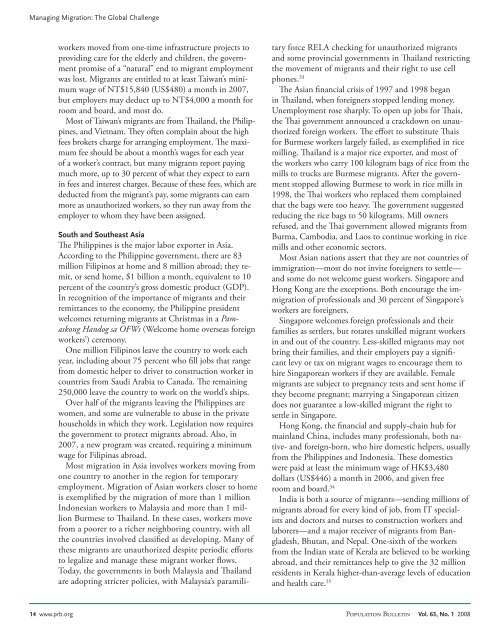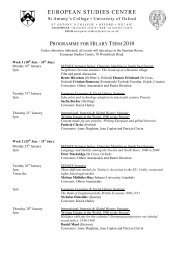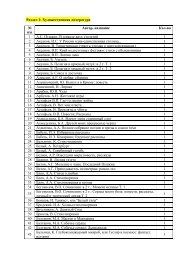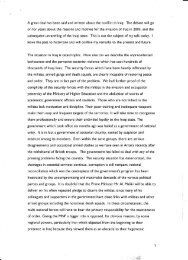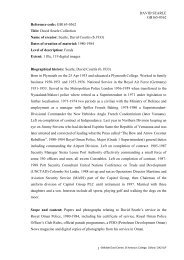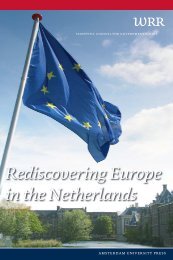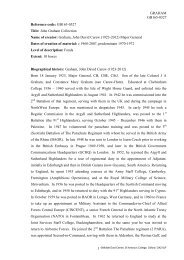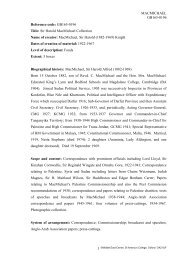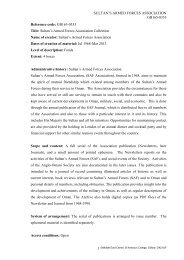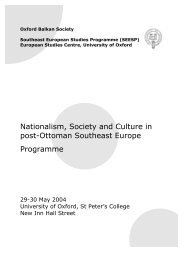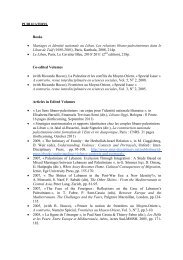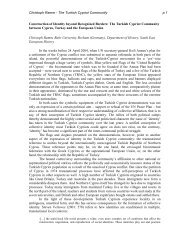Managing Migration: The Global Challenge, Population Bulletin, Vol ...
Managing Migration: The Global Challenge, Population Bulletin, Vol ...
Managing Migration: The Global Challenge, Population Bulletin, Vol ...
You also want an ePaper? Increase the reach of your titles
YUMPU automatically turns print PDFs into web optimized ePapers that Google loves.
<strong>Managing</strong> <strong>Migration</strong>: <strong>The</strong> <strong>Global</strong> <strong>Challenge</strong><br />
workers moved from one-time infrastructure projects to<br />
providing care for the elderly and children, the government<br />
promise of a “natural” end to migrant employment<br />
was lost. Migrants are entitled to at least Taiwan’s minimum<br />
wage of NT$15,840 (US$480) a month in 2007,<br />
but employers may deduct up to NT$4,000 a month for<br />
room and board, and most do.<br />
Most of Taiwan’s migrants are from Thailand, the Philippines,<br />
and Vietnam. <strong>The</strong>y often complain about the high<br />
fees brokers charge for arranging employment. <strong>The</strong> maximum<br />
fee should be about a month’s wages for each year<br />
of a worker’s contract, but many migrants report paying<br />
much more, up to 30 percent of what they expect to earn<br />
in fees and interest charges. Because of these fees, which are<br />
deducted from the migrant’s pay, some migrants can earn<br />
more as unauthorized workers, so they run away from the<br />
employer to whom they have been assigned.<br />
South and Southeast Asia<br />
<strong>The</strong> Philippines is the major labor exporter in Asia.<br />
According to the Philippine government, there are 83<br />
million Filipinos at home and 8 million abroad; they remit,<br />
or send home, $1 billion a month, equivalent to 10<br />
percent of the country’s gross domestic product (GDP).<br />
In recognition of the importance of migrants and their<br />
remittances to the economy, the Philippine president<br />
welcomes returning migrants at Christmas in a Pamaskong<br />
Handog sa OFWs (Welcome home overseas foreign<br />
workers’) ceremony.<br />
One million Filipinos leave the country to work each<br />
year, including about 75 percent who fill jobs that range<br />
from domestic helper to driver to construction worker in<br />
countries from Saudi Arabia to Canada. <strong>The</strong> remaining<br />
250,000 leave the country to work on the world’s ships.<br />
Over half of the migrants leaving the Philippines are<br />
women, and some are vulnerable to abuse in the private<br />
households in which they work. Legislation now requires<br />
the government to protect migrants abroad. Also, in<br />
2007, a new program was created, requiring a minimum<br />
wage for Filipinas abroad.<br />
Most migration in Asia involves workers moving from<br />
one country to another in the region for temporary<br />
employment. <strong>Migration</strong> of Asian workers closer to home<br />
is exemplified by the migration of more than 1 million<br />
Indonesian workers to Malaysia and more than 1 million<br />
Burmese to Thailand. In these cases, workers move<br />
from a poorer to a richer neighboring country, with all<br />
the countries involved classified as developing. Many of<br />
these migrants are unauthorized despite periodic efforts<br />
to legalize and manage these migrant worker flows.<br />
Today, the governments in both Malaysia and Thailand<br />
are adopting stricter policies, with Malaysia’s paramilitary<br />
force RELA checking for unauthorized migrants<br />
and some provincial governments in Thailand restricting<br />
the movement of migrants and their right to use cell<br />
phones. 33<br />
<strong>The</strong> Asian financial crisis of 1997 and 1998 began<br />
in Thailand, when foreigners stopped lending money.<br />
Unemployment rose sharply. To open up jobs for Thais,<br />
the Thai government announced a crackdown on unauthorized<br />
foreign workers. <strong>The</strong> effort to substitute Thais<br />
for Burmese workers largely failed, as exemplified in rice<br />
milling. Thailand is a major rice exporter, and most of<br />
the workers who carry 100 kilogram bags of rice from the<br />
mills to trucks are Burmese migrants. After the government<br />
stopped allowing Burmese to work in rice mills in<br />
1998, the Thai workers who replaced them complained<br />
that the bags were too heavy. <strong>The</strong> government suggested<br />
reducing the rice bags to 50 kilograms. Mill owners<br />
refused, and the Thai government allowed migrants from<br />
Burma, Cambodia, and Laos to continue working in rice<br />
mills and other economic sectors.<br />
Most Asian nations assert that they are not countries of<br />
immigration—most do not invite foreigners to settle—<br />
and some do not welcome guest workers. Singapore and<br />
Hong Kong are the exceptions. Both encourage the immigration<br />
of professionals and 30 percent of Singapore’s<br />
workers are foreigners.<br />
Singapore welcomes foreign professionals and their<br />
families as settlers, but rotates unskilled migrant workers<br />
in and out of the country. Less-skilled migrants may not<br />
bring their families, and their employers pay a significant<br />
levy or tax on migrant wages to encourage them to<br />
hire Singaporean workers if they are available. Female<br />
migrants are subject to pregnancy tests and sent home if<br />
they become pregnant; marrying a Singaporean citizen<br />
does not guarantee a low-skilled migrant the right to<br />
settle in Singapore.<br />
Hong Kong, the financial and supply-chain hub for<br />
mainland China, includes many professionals, both native-<br />
and foreign-born, who hire domestic helpers, usually<br />
from the Philippines and Indonesia. <strong>The</strong>se domestics<br />
were paid at least the minimum wage of HK$3,480<br />
dollars (US$446) a month in 2006, and given free<br />
room and board. 34<br />
India is both a source of migrants—sending millions of<br />
migrants abroad for every kind of job, from IT specialists<br />
and doctors and nurses to construction workers and<br />
laborers—and a major receiver of migrants from Bangladesh,<br />
Bhutan, and Nepal. One-sixth of the workers<br />
from the Indian state of Kerala are believed to be working<br />
abroad, and their remittances help to give the 32 million<br />
residents in Kerala higher-than-average levels of education<br />
and health care. 35<br />
14 www.prb.org <strong>Population</strong> <strong>Bulletin</strong> <strong>Vol</strong>. 63, No. 1 2008


